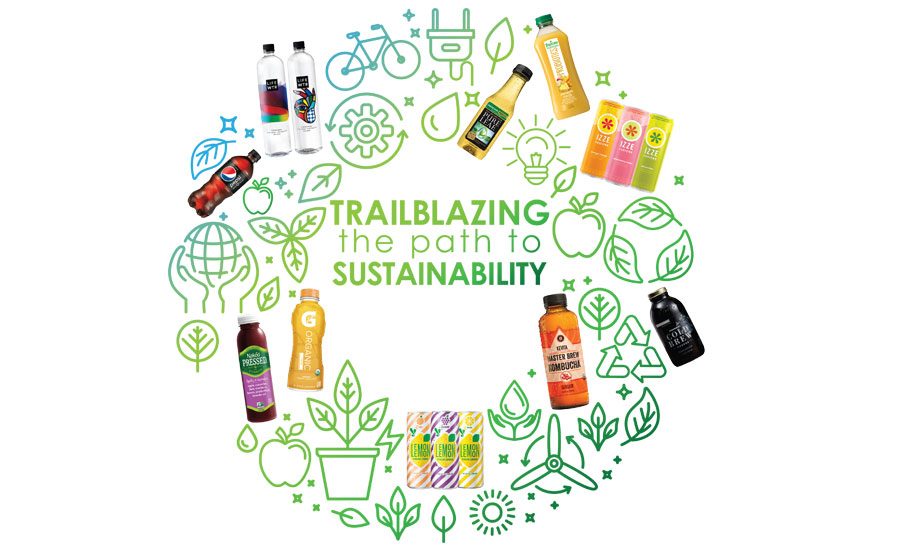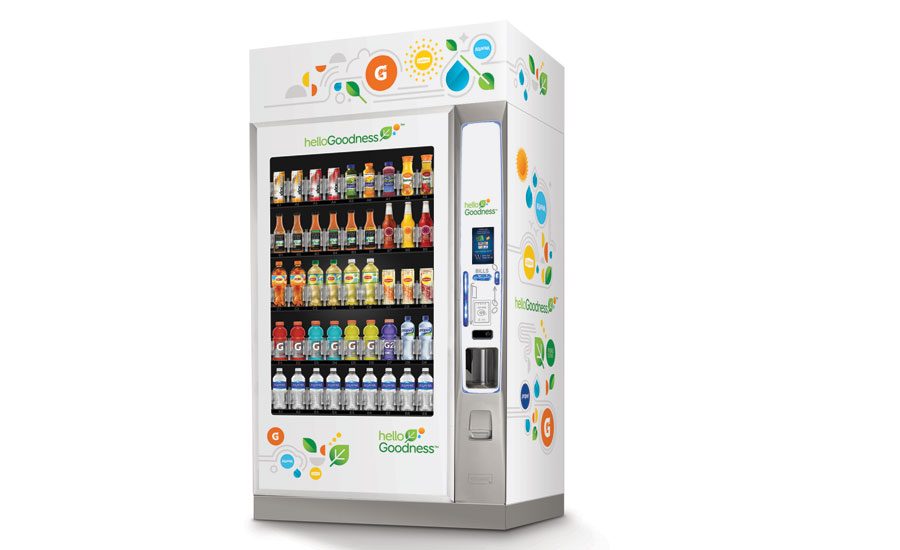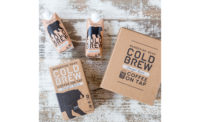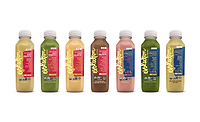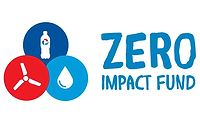Greek Philosopher Heraclitus once said, “Big results require big ambitions.” For Purchase, N.Y.-based PepsiCo Inc., that statement rings true as the global food and beverage manufacturer has embarked on a goal to develop better products for consumers and the planet.
This food and beverage journey harkens back to 2006 when PepsiCo announced its Performance with Purpose initiative, which “is focused on sustainable, long-term growth while leaving a positive imprint on society and the environment,” the company states. However, in 2016, the company took the initiative a step further with the announcement of its 2025 Sustainability Agenda.
“We began our Performance with Purpose journey in 2006 and as we approached the 10-year milestone it was a good time to reaffirm our commitment to delivering strong long-term financial results in a way that is sensitive to the needs of the world around us,” says René Lammers, senior vice president of global beverage research and development (R&D) for PepsiCo. “With our 2025 Sustainability Agenda, we saw an opportunity to use our global scale and resources to influence positive change across our value chain. We believe that the path toward a more sustainable food system — from raw materials to post-consumer — is collaborative, and our hope is that by setting an ambitious agenda, we will inspire others to act and contribute solutions to shared challenges.”
The 2025 Sustainability Agenda is a continuation of Performance with Purpose that includes specific 2025 goals across three core priorities:
- Helping to improve health and well-being through the products it sells.
- Protecting the planet.
- Empowering people around the world.
Included in those specific 2025 goals is that at least two-thirds of its global beverage portfolio will contain 100 calories or fewer from added sugars in each 12-ounce serving.
This goal, as well as its additional specific 2025 goals, was influenced by research and information from experts around the globe, Lammers notes.
“All of our new goals were informed by many of the world’s leading experts and institutions and were mapped out against the United Nation’s Sustainable Development Goals,” he says. “In the case of our product goals, our sugar-reduction target was informed by the latest dietary guidelines of the World Health Organization and other global authorities.”
Although PepsiCo made its Sustainability Agenda announcement in October 2016, the company already has made early progress and is looking forward to reaching its 2025 goals, Lammers adds. But as the company aims to reduce added-sugars, key factors will impact its journey.
“There are really two factors that will be key to our success in meeting our added-sugar goal,” Lammers says. “The first is portfolio diversification and the second is product development of superior low- and no-calorie beverages. As you know, our beverage portfolio transformation journey began more than< 20 years ago as we first established our goal of becoming a Total Beverage Company.
“As a result, today, about half of our U.S. beverage volume comes from water, low- or no-calorie beverages, 100-percent juice or active hydration, and our average calories per serving has dropped by nearly 20 percent,” he continues. “At the same time, we’ve increased our investment in R&D to ensure that we can provide our consumers with low- and no-calorie refreshment without sacrificing taste.”
A focused investment
As PepsiCo looks to advance its sugar-reduction efforts, Lammers and his team remain focused on its efforts to develop “superior-tasting low- and no-calorie beverages.” However, he notes that these efforts must remain in line with consumer trends.
“We are also staying close to consumer trends and work with our nutrition science team to stay abreast of the latest science in that space, and all of that influences our work,” he says. “We are fortunate to have a team of some of the most experienced product developers and flavor technologists in the industry, and we’ve been able to stay at the forefront of sugar reduction, consistently going back to being the first mainstream player to launch a stevia-sweetened drink in the U.S.”
Although PepsiCo has had success with its stevia-sweetened products like Trop50, Lammers explains that the company remains ambitious in pursuing additional sweetener solutions.
“There is really no stone left unturned when it comes to sweetener systems; we are definitely focused on both sweetener blends and new sweetener developments but that is just one part of the equation,” he says. “We take a full-system approach to balancing our flavor systems to optimize the sweetness profile that is right for the application.
“For example, if we are working on a reformulation, our goal might be to match the sweetness profile of the original product to achieve parity or preference in consumer testing,” Lammers continues. “When it comes to new product development, we start by asking what the right sweetness profile is to begin with and then develop a flavor system that would allow us to achieve that with as few added sugars as possible.”
However, Lammers recognizes that sugar reduction is not without its own obstacles. “Shifting consumer attitudes around low-calorie sweeteners has posed a challenge,” he says. “Natural sweeteners continue to be a focus for us — and others in the industry — as we look to satisfy consumer interest in clean labels and fewer artificial ingredients. Fortunately, we have considerable experience in formulating with stevia, which has provided us with a solid foundation for this work. We are getting better every day at working with existing sweeteners and will continue to explore new options as well.”
Yet, sugar reduction is not the only focus for the company. Another specific 2025 goal for PepsiCo is for the rate of sales growth of its Everyday Nutrition products to outpace the rate of sales growth in the balance of its portfolio. Additionally, the company aims to provide at least 3 billion servings of nutritious foods and beverages to underserved communities and consumers.
“While we have specific product goals around [the] reduction of added sugars and other ‘nutrients to limit,’ we also have set a goal that the growth of our Everyday Nutrition products will outpace that rate of growth in the balance of our portfolio,” Lammers says. “We also aim to increase access to positive nutrition in underserved communities. To meet this goal, in addition to spending more of our R&D effort against low- and no-calorie beverage options, we also have product nutrition criteria that encourages our teams to consider value-added ingredients and innovation in the areas of hydration, fruits- and vegetable-based products, and dairy.”
Lammers notes that clean-label and value-added trends can be contradictory, but through its research, PepsiCo has found opportunities to add value while keeping shorter ingredient list goals in mind.
“What we’ve found is that consumer acceptance can vary depending on the application — they may want fortification or value-added in one beverage while in another they want minimal processing and short ingredient lists,” Lammers says. “Our launch of Tropicana Probiotics earlier this year is an example of a value-added proposition that has really resonated with consumers.
“The response to a fruit juice-based probiotic has been overwhelmingly positive,” he continues. “It took considerable development work to find the right juice blends and the right probiotic strains to make the product work, but we were able to draw on our deep fruit juice expertise as well as draw on knowledge from some of our dairy products in Europe and Russia.”
With the progressive evolution of the beverage market in mind, PepsiCo is keeping close watch of emerging trends as well as opportunities to reinvent established categories. However, the company maintains a disciplined approach to evaluate consumer trends versus consumer gimmicks.
“We are always working to keep our finger on the pulse of emerging categories,” Lammers says. “We do extensive market research and consumer insights work to make sure we are close to trends. We also have teams on both the brand marketing and R&D side that are focused on ‘venturing’ and considering opportunities for partnership or acquisition. KeVita is a great example of a brand we partnered with and ultimately acquired.
“The beverage market is extremely dynamic — there is always something new on the horizon, but not everything will last,” he continues. “We try to focus our energy on what has staying power with the consumer and the scale necessary to be a success for our system.”
Much energy also is being dedicated to taking popular beverage categories and updating them to align with current market trends, he says.
“You’ve seen some of our progress with the recent launches of products like Mountain Dew Kickstart, Lemon Lemon and IZZE Fusions — all of which have less added sugar than traditional soft drinks but are not marketed as ‘light’ or ‘diet’ and do not have any of the taste compromises that consumers traditionally associate with ‘reduced sugar’ products,” Lammers explains.
Proof is in the products
The R&D department’s dedicated efforts to the specific 2025 goals and continual innovation are a testament to the metamorphosis of PepsiCo’s portfolio.
“PepsiCo has already been on a beverage transformation journey in the U.S. for more than two decades,” says Greg Lyons, chief marketing officer of PepsiCo North America Beverages. “We’ve vastly expanded beyond our iconic soft drink brands with offerings such as premium and sparkling water, teas, sports drinks, juices, craft colas and coffee drinks — giving consumers top-selling beverages for every lifestyle and occasion.
“Through our own product innovations, acquisitions and strategic alliances, we’ve introduced brands to meet the evolving tastes and expectations of our consumers,” he continues. “We’re fueled by providing choice, including low- and no-calorie beverages made with trusted ingredients and in package sizes consumers want. We’re also giving more marketing exposure to our low- and no-calorie beverages such as Pepsi Zero Sugar and LIFEWTR, among other brands.”
Those new innovations include the previously mentioned Lemon Lemon, a combination of lemon juice, bubbles and a touch of sweetness. Released earlier this year, Lemon Lemon — available in Original, Blackberry and Peach — was developed based on consumer insights suggesting that existing lemonade drinkers want sparkling options.
With only 70 calories in a 12-ounce serving, Lemon Lemon is free of artificial flavors and sweeteners. The company also notes that it thinks this category possesses a lot of promise and early consumer feedback highlights a positive response to the packaging, flavors and low-calorie proposition.
However, Lemon Lemon is not PepsiCo’s only sparkling option to hit the market this year. IZZE Fusions is a better-for-you sparkling refreshment option that leverages the company’s IZZE trademark.
Although both are lower-calorie sparkling options, Lemon Lemon is a lemonade-forward beverage that targets millennials, while IZZE Fusions is a mashup of juice, soft drinks and sparkling water that targets the iGeneration and its parents, the company says.
Available in Orange Mango, Lemon Lime and Strawberry Melon, IZZE Fusions contains 60 calories in each 12-ounce serving and is designed to address the unmet “cool hydration” options for teens while keeping in line with the health-and-wellness aspirations parents want for their families.
“We consider products like IZZE Fusions and Lemon Lemon to be ‘next-generation CSDs’ — modernized soft drinks with unique flavors and lower calorie counts,” Lyons says. “The liquid refreshment beverage category is transforming, and we feel that products like these, which also contain no artificial sweeteners or flavors, are leaders in our portfolio transformation journey as we look to provide consumers with the options they want.”
However, reinvention of the carbonated soft drink (CSD) category also includes appealing to the more sophisticated consumption moments, which PepsiCo is addressing through its Mtn Dew Label Series and 1893 from the Makers of Pepsi-Cola brands.
“Mtn Dew Black Label has been part of the Dew portfolio since 2015 when it was released exclusively at approximately 600 colleges and universities, giving students a first taste,” Lyons says. “Students loved Mtn Dew Black Label and the product flew off campus shelves. Then, when it launched nationwide in 2016, it became one of the most successful individual product launches in Dew history, elevating the Dew Nation’s drinking experience with new and unique flavors and premium ingredients. With the release of Mtn Dew White and Green Labels, we wanted to build on Black Label’s success and create a new and distinctive platform for the Dew brand.”
Mtn Dew Black Label was developed with premium ingredients including dark berry flavor and herbal bitters, the company says. The 2017 addition of White and Green Labels expanded the premium options. Mtn Dew White Label offers a citrus-flavored variety, while Mtn Dew Green Label is an apple-kiwi amalgamation.
For 1893, the craft soda’s inspiration dates back to the original recipe by Pepsi founder Caleb Bradham and, like the Mtn Dew Label Series, combines premium ingredients. Released in 2016 in Original Cola and Ginger Cola, PepsiCo expanded the lineup this year with Black Currant Cola and Citrus Cola.
Citrus Cola features a balance of 1893’s Original Cola with grapefruit essences, while Black Currant Cola infuses black currant essences into the Original Cola recipe, the company notes.
But perhaps what separates 1893 from other craft sodas on the market is its connection to the cocktail and mixology arena. A significant portion of the brand’s identity stems from mixology, and the company has employed marketing activations that highlight cocktail strategy, consumer events as well as engagement within the bar community, it explains.
Within the CSD category, PepsiCo also recognizes that consumers are looking for a variety of choices, including zero-calorie and zero-sugar offerings. This need state motivated the company to rebrand Pepsi MAX as Pepsi Zero Sugar. “The shift was made to more clearly communicate to consumers that it is a zero-calorie product,” a representative says.
Yet, premium offerings and innovations have not been limited to next-generation CSDs. PepsiCo also is addressing healthy hydration through its launch of LIFEWTR, a premium bottled water that is pH balanced with added electrolytes for taste and hydration.
“Our water portfolio is a priority for PepsiCo, with LIFEWTR and Aquafina leading the charge. We continue to be committed to meeting the growing consumer demand for bottled water in the U.S. as Americans will each drink just over 27 gallons of bottled water this year,” Lyons says, citing Euromonitor International data. “In February, we launched our premium bottled water LIFEWTR. The consumer reaction has surpassed expectations — in just five months of sales since its launch in Q1, LIFEWTR has already reached $70 million in retail sales across measured channels, was the top brand contributing to liquid refreshment beverage retail sales growth in the second quarter and is on track to generate approximately $200 million in retail sales on an annualized basis.”
What helps LIFEWTR stand out on retail store shelves is its label series, which features works from various artists. By offering a platform for these artists, LIFEWTR aims to be an inspiration of creativity. The Series 1 labels showcased emerging artists in the public art space, while the recently released Series 2 labels highlight emerging female artists.
“The brand’s purpose is to fuse creativity and design to serve as a source of inspiration, as well as hydration, and the product’s label serves as a rotating platform for emerging artists to be seen and discovered on a broad scale,” Lyons explains. “Our research showed us that shoppers in the premium water category are driven by attractive packaging, a cool and trendy design, and a pure, clean taste. LIFEWTR delivers all of this and more.”
With such a diverse U.S. beverage market, PepsiCo’s innovative expertise has not been limited to CSDs and bottled water. The company also saw opportunities to address sugar reduction and premium offerings with its Pure Leaf Unsweetened and Pure Leaf Tea House Collection ready-to-drink (RTD) teas.
Pure Leaf Unsweetened contains zero calories and is available in three varieties: Unsweetened Black Tea, Unsweetened Black Tea with Lemon and Unsweetened Green Tea.
With Pure Leaf Tea House Collection, the super-premium line utilizes the finest organic tea leaves in combination with fruits and herbs, the company says.
“Through the Pepsi Lipton Tea partnership, a joint venture between PepsiCo and Unilever that includes ready-to-drink iced teas for every occasion, PepsiCo continues to innovate in this growing category with our Pure Leaf, Lipton and Brisk brands,” Lyons says. “Our robust tea expertise allows us to come to market with innovations that truly meet consumer demand, including products like Pure Leaf Unsweetened and Pure Leaf Tea House Collection.”
PepsiCo also has been able to build upon its North America Coffee Partnership with Starbucks Coffee Co. through the release of many RTD coffee beverages, including Starbucks Cold Brew. The newest ready-to-drink coffee option offers consumers a convenient, cold-steeped cold-brew coffee, which is available in Unflavored and Cocoa & Honey with Cream varieties.
However, convenience isn’t limited to RTD teas and coffees. Consumers also are wanting on-the-go nutritional beverages. Whether through recent acquisitions, such as KeVita and its portfolio of fermented probiotic and kombucha beverages, or innovations within other portfolios, including Tropicana or Naked Juice, PepsiCo recognizes the diverse need states of today’s consumers.
“Tropicana Probiotics, Naked Botanicals and the entire KeVita portfolio are examples of the innovation we’re bringing to market to meet the needs of health-oriented consumers,” says Seth Kaufman, president of PepsiCo North America Nutrition. “To adapt to the rapidly evolving health-and-wellness landscape, we will continue to aggressively launch on-trend nutritional offerings that resonate with this highly discerning consumer.”
Released in 2016, Tropicana Probiotics was developed to deliver consumers a 100 percent juice fortified with probiotics. Each 8-ounce serving of Tropicana Probiotics provides 1 billion live and active cultures, the company says.
Through its release of Naked Pressed Botanical Juices, PepsiCo is offering consumers’ refreshment by cold-pressing fruits and vegetables with botanical ingredients. Available in Apples to Lavender and Citrus Lemongrass varieties, Naked Pressed Botanical Juices have no added sugar, no preservatives and are verified by the Non-GMO Project, the company says.
Another beverage category in which PepsiCo sees a growing need state is sports nutrition. Although Gatorade commands the largest market share within the sports drink category, based on data from Information Resources Inc., the company also recognizes the unique needs states of individual athletes.
That recognition resulted in the development of Gatorade Flow, the newest flavor sub-line of Gatorade Thirst Quencher. Gatorade Flow provides a different sensory experience than Gatorade’s existing offerings by delivering a full flavor and smooth finish, the company says.
Gatorade also addressed the growing demand for organic beverages with its launch of G Organic. “We know that athletes are unique in many ways, including their sports fuel preferences,” a company representative says. “As part of our targeted hydration portfolio, we’ve created G Organic for those athletes looking for an organic hydration and fueling option that is USDA certified while still providing the proven fueling benefits found in Gatorade Thirst Quencher.”
Although PepsiCo might be recognized for innovations within the beverage market, the company and its R&D team have dedicated attention to the channels where consumers purchase these products, ensuring support of its Performance with Purpose journey. Through the development of its Hello Goodness vending machine platform in the United States, PepsiCo is providing consumers with a range of better-for-you food and beverage products, including Aquafina Sparkling, Pure Leaf iced tea, Naked Juice and more. In fact, the platform is expanding to schools including the University of Utah where 34 co-branded Hello Goodness vending machines will be placed throughout the campus.
And later this year, PepsiCo will report on the global progress of its 2025 Sustainability Agenda with 2016/2017 data. As the R&D department continues to develop new products and research new solutions, the company plans to build on the accomplishments it already has achieved.
“A legacy of the portfolio diversification efforts we’ve undertaken over the past few decades is a breadth and depth of beverage product development knowledge that I believe is unmatched in the industry,” Lammers says. “The progress that you’re seeing with our new product launches today is the direct result of that rich history. Every new product we’ve launched over the years and every technical challenge that we’ve overcome is now part of the toolbox that we have at our disposal to drive transformation.” BI

